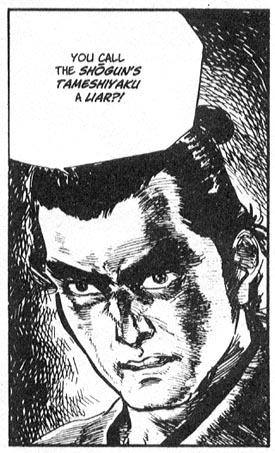 Written by Kazuo Koike
Written by Kazuo Koike
Art by Goseki Kojima
312 pages, black and white
Published by Dark Horse
One of my earliest exposures to the world of comics in Japan was First Comics’s translations of Lone Wolf & Cub. Kazuo Koike and Goseki Kojima’s epic enthralled me from the very first page, and when Dark Horse brought it back into print several years ago I was overjoyed that I could finally read the story that had grabbed my attention all those years earlier. Now Dark Horse is publishing Samurai Executioner, Koike and Kojima’s spin-off of a minor character from Lone Wolf & Cub. When it comes to the sense of wonder that the duo had with their earlier collaboration, the question quickly becomes: can lightning really strike twice?
Kubikiri Asa is the Emperor’s beheader, dispensing the killing stroke to criminals who are condemned to death. The job requires more than just a swift blade, though; it is a job for someone with great integrity and commitment to both the country and its people. Fortunately for the people of Japan, Kubikiri Asa is just that man.
I’ll admit that when I first started reading Samurai Executioner I was more than a little wary of the series. How interesting, I asked myself, can a series be about someone whose purpose in life is to chop off people’s heads? What I hadn’t realized is that in many ways, that’s little more than the punctuation to the stories. In just two volumes, we’ve had dramas involving kidnapping, corrupt officers of the law, pyromaniacs, and more. In some of the stories, Asa is barely more than a brief presence at its conclusion; in others, he’s the driving force that keeps the action moving. In many ways Asa is the flip side of Lone Wolf & Cub Ogami Itto; while both of them are deeply honorable men, Asa is anything but a fugitive from the law, instead upholding its ideals. In many ways, Samurai Executioner is almost an answer to the question of what Itto’s life must have been like before the betrayals of Lone Wolf & Cub began. One warning to squeamish readers, though: Samurai Executioner is unflinching when it comes to violence and death. While it certainly goes with the territory of the stories told, those who are disturbed by that sort of thing should certainly look elsewhere.
 Kojima’s art, like in Lone Wolf & Cub, lends itself quite well to the artist-mandated 4×7″ format. This tightly compact art style uses its dark inks to great effect, from thin and careful lines to delineate wrinkles on faces to large splatters of blood that arc across the panels. Where Kojima excels is in his depiction of action, with strokes of the sword whistling across the page, and in his drawing of Asa and the ability to show Asa’s every emotion entirely through the art, never needing to rely on the dialogue. On the other hand, the more you read of Samurai Executioner, the more you realize that Kojima only has a certain number of faces that he can draw; Asa and Itto look awfully similar to me, and a lot of the supporting cast is only distinguishable by their age and clothing. On the bright side, the smaller size of the book does a good job of hiding the fact that Kojima often leaves out backgrounds in his art; what would be large expanses of white in a larger format is instead small and compact here.
Kojima’s art, like in Lone Wolf & Cub, lends itself quite well to the artist-mandated 4×7″ format. This tightly compact art style uses its dark inks to great effect, from thin and careful lines to delineate wrinkles on faces to large splatters of blood that arc across the panels. Where Kojima excels is in his depiction of action, with strokes of the sword whistling across the page, and in his drawing of Asa and the ability to show Asa’s every emotion entirely through the art, never needing to rely on the dialogue. On the other hand, the more you read of Samurai Executioner, the more you realize that Kojima only has a certain number of faces that he can draw; Asa and Itto look awfully similar to me, and a lot of the supporting cast is only distinguishable by their age and clothing. On the bright side, the smaller size of the book does a good job of hiding the fact that Kojima often leaves out backgrounds in his art; what would be large expanses of white in a larger format is instead small and compact here.
Samurai Executioner is a pleasantly good book; after two volumes I’m definitely interested in more, although knowing that there are only eight volumes in all may have something to do with that since I’m not entirely sure that Asa could support a twenty-eight volume epic of his own. For readers who’ve been feeling a gap in their lives since Dark Horse’s Lone Wolf & Cub reprints ended, look no further.
Purchase Links:
